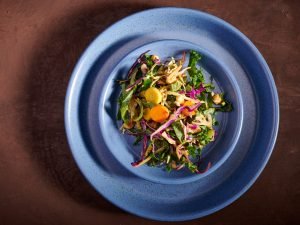24 GREAT Serving Ideas for Cruciferous Vegetables
Cruciferous vegetables are being researched for their cancer-inhibiting phytochemicals. See an excellent summary from cancer.gov or download a fact sheet from the National Institute of Health. Cruciferous vegetables are a part of the Brassica genus of plants and include these vegetables:
- Arugula
- Bok choy
- Broccoli
- Brussels sprouts
- Cabbage
- Cauliflower
- Collard greens
- Horseradish
- Kale
- Radishes
- Rutabaga
- Turnips
- Watercress
- Wasabi
The key to success with cruciferous vegetables is getting people to eat them! While most people love broccoli and kale salad is widely available in restaurants and grocery stores, there are a whole lot more than can be consumed on a regular basis.
Here are 24 great suggestions for cruciferous vegetables:1. Sprinkle raw rutabaga strips lightly with flavored vinegar and your favorite salt-free seasoning (Italian herbs or Mrs. Dash).2. Boil turnips or rutabagas with potatoes and then mash them with skim milk, garlic powder and butter granules.3. Finish steamed Brussels sprouts by sautéing with olive oil spray and minced garlic.4. Caramelize onions in a nonstick pan with a little vegetable oil spray, add cabbage, apples and chicken broth; cook lightly until tender.5. Peel broccoli stems and serve raw. The stems are very sweet, tender and crisp without the tough outer skin.6. Saute onions, cubed potatoes and curry powder in some broth. Cook until potatoes are tender and then add cauliflower. Fold in nonfat yogurt right before serving.7. Cabbage is good when combined raw with raspberry jelly, raspberry vinegar, crushed pineapple and nonfat mayo.8. Microwave (or steam) broccoli, kale, or Brussels sprouts until tender. Serve with fresh squeezed lemon juice and freshly ground black pepper.9. Place turnips, sweet potatoes, onions and carrots in chicken broth. Roast together in 400º oven for 45 minutes. Stir frequently and add more liquid as needed.10. Make a white sauce with low-fat, reduced-sodium cream of chicken soup and nutmeg; serve it with steamed broccoli, cauliflower, broccoli rabe or kale.11. Spread low-fat or nonfat ricotta cheese over the top of raw broccoli or cauliflower and microwave until tender.12. Keep a bunch of broccoli in your refrigerator at all times. Throw it into salads or stir frys. Serve raw with dips for snacks.13. From a cook whose husband hates vegetables: “I have to hide them in foods so he’ll eat them. I cut the broccoli or cauliflower into small pieces and put it into marinara sauce and serve on pizza or pasta.”14. Shredded, raw turnips are great for salads. You can also use them to top veggie tacos - it looks like cheese!15. Freezing a head of cabbage makes it easier to peel off the leaves and roll them for stuffing. Use a bean and rice filling.16. Best topping-after-steaming for one family: a little squirt of I can’t believe it’s not Butter and some grated parmesan cheese sprinkled over the top.17. Chop and steam kale; serve over small-shaped pasta such as bowties or small shells. Finish with a light spray of olive oil, black pepper and parmesan cheese.18. Steam chopped kale and use it to top pizza along with your other favorite veggies.19. Chop broccoli fine and use it in your egg white omelette along with mushrooms and tomatoes.20. Cauliflower can be chopped find or bought as "pearled" or "riced" and it can be quickly steamed or baked in the oven right alongside whatever you are roasting like a chicken breast or fillet of fish.21. Make a broccoli salad with turkey-bacon, onion, raisins, sunflower seeds and fresh mushrooms. Toss with nonfat coleslaw dressing.22. Cut broccoli, radishes, and cauliflower into bite-sized pieces and serve with hummus to make a crudite platter.23. Lightly spray cauliflower with olive oil spray and coat with your favorite seasonings. Bake at 450 degrees until crisp tender. Favorite seasonings might include an Indian Tika Masala spice mix, Italian Seasoning, or chili spice mix.24. Make a crunchy slaw using a cruciferous slaw mix that is a mix of cruciferous vegetables or one made with Brussels sprouts or broccoli. "Beef it up" with baby kale. Simply add a balsamic vinaigrette, toasted nuts, chili peppers, and diced carrots for a flavorful, crunchy slaw treat that has a hip factor.

 Here is a Crunchy Cruciferous Slaw recipe: Crunchy Cruciferous SlawOr view the recipe in our member-only recipe database: Crunchy Cruciferous Slaw[shopify embed_type="collection" shop="nutrition-education-store.myshopify.com" product_handle="new-products"]
Here is a Crunchy Cruciferous Slaw recipe: Crunchy Cruciferous SlawOr view the recipe in our member-only recipe database: Crunchy Cruciferous Slaw[shopify embed_type="collection" shop="nutrition-education-store.myshopify.com" product_handle="new-products"]
